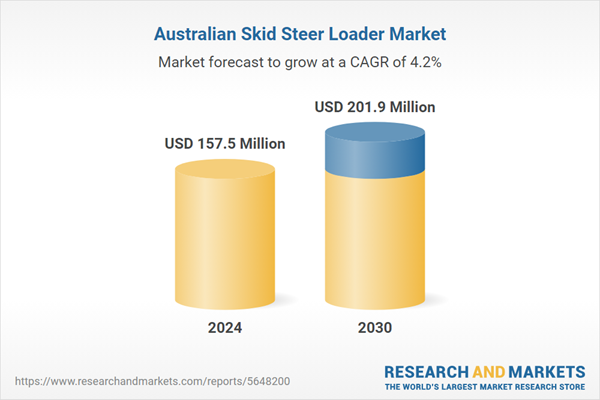Free Webex Call
The Australia Skid Steer Loader Market was valued at USD 157.5 Million in 2024, and is expected to reach USD 201.9 Million by 2030, rising at a CAGR of 4.23%. The Australia skid steer loader market is witnessing significant growth, supported by expanding construction activity across diverse sectors such as infrastructure, mining, and landscaping. The demand for compact and agile machinery that offers versatile functionality in confined spaces is influencing fleet expansion among contractors. Technological advancements in skid steer loaders, such as telematics integration, improved hydraulic performance, and operator-friendly features, are strengthening their adoption. Government emphasis on modernizing public infrastructure and increasing private sector involvement in real estate development further boost the equipment demand. Speak directly to the analyst to clarify any post sales queries you may have.
10% Free customizationThis report comes with 10% free customization, enabling you to add data that meets your specific business needs.
Market trends are evolving toward electric and hybrid skid steer loaders as sustainability concerns gain momentum. Manufacturers and operators are focusing on reducing emissions and lowering total operating costs by adopting battery-powered models for urban operations. Moreover, the rise of rental services has made equipment more accessible to small and medium-scale contractors. The convenience of on-demand availability without high upfront capital costs is creating a favorable environment for short- and mid-term projects.
Despite robust demand, challenges such as high initial investment, periodic maintenance costs, and skilled labor shortages affect market performance. High ownership costs make smaller contractors cautious about procurement decisions. The need for trained operators to handle advanced control systems adds pressure to maintain workforce quality. Environmental regulations around noise and emissions standards also create compliance challenges. Still, rising automation and connectivity present future growth avenues by enabling remote diagnostics and fleet management, aligning the sector with digital construction trends.
Market Drivers
Infrastructure Expansion
Australia’s ongoing development of roads, railways, and public facilities is fueling demand for construction equipment that can perform diverse tasks in tight work zones. The ABS data 2025, revealed that engineering construction work reached AUD 35.36 billion, with a 4.5% year-on-year growth. These projects include civil infrastructure, roads, and utilities, key application areas where skid steer loaders support earthmoving, trenching, and material handling operations. Skid steer loaders offer high versatility with attachments suited for grading, trenching, and debris removal. Their maneuverability allows them to access constrained areas in urban infrastructure sites, supporting a wide range of municipal and utility works. The push to upgrade aging infrastructure while launching new projects under government initiatives ensures sustained demand from civil contractors seeking flexible and efficient machinery for faster turnaround times.Key Market Challenges
High Equipment Acquisition Costs
Purchasing a new skid steer loader involves substantial upfront costs, which can be prohibitive for small contractors or startups. The investment increases when buyers seek advanced features like telematics, joystick controls, and emissions-compliant engines. Limited access to affordable financing options also restricts procurement decisions. In markets with growing competition, the inability to upgrade or expand fleets can hamper operational competitiveness and discourage project bids, particularly in large-scale commercial or infrastructure developments.Key Market Trends
Electrification of Equipment
With increasing focus on sustainable practices, there is a noticeable shift toward electric-powered skid steer loaders. These machines offer reduced emissions, lower noise levels, and decreased fuel dependency, making them suitable for indoor or urban use. Charging infrastructure development and advancements in battery performance are making electric options more viable. Operators are exploring these machines to meet green building standards, regulatory mandates, and corporate ESG goals, signaling a shift in future procurement strategies.Key Market Players
- Ace Torwel Inc.
- Bobcat Company
- CASE Construction Equipment
- Caterpillar Inc.
- CNH Industrial America LLC
- Deere and Company
- Komatsu Ltd.
- Liebherr Group
- Volvo Construction Equipment AB
- Xuzhou Construction Machinery Group Co., Ltd.
Report Scope:
In this report, the Australia Skid Steer Loader Market has been segmented into the following categories, in addition to the industry trends which have also been detailed below:Australia Skid Steer Loader Market, By Lift:
- Radial
- Vertical
Australia Skid Steer Loader Market, By Operating Capacity:
- Up to 1550 lbs.
- 1550 lbs. - 2000 lbs.
- 2000 lbs. - 3000 lbs.
- 3000 - 4000 lbs.
- More than 4000 lbs.
Australia Skid Steer Loader Market, By Propulsion:
- ICE
- Electric
Australia Skid Steer Loader Market, By End Use:
- Construction
- Mining
- Agriculture
- Industrial
- Municipal
- Others
Australia Skid Steer Loader Market, By Region:
- New South Wales
- Victoria & Tasmania
- Queensland
- Western Australia
- Northern Territory & Southern Australia
Competitive Landscape
Company Profiles: Detailed analysis of the major companies present in the Australia Skid Steer Loader Market.Available Customizations:
With the given market data, the publisher offers customizations according to the company’s specific needs. The following customization options are available for the report.Company Information
- Detailed analysis and profiling of additional market players (up to five).
Table of Contents
1. Introduction
2. Research Methodology
3. Executive Summary
4. Australia Skid Steer Loader Market Outlook
5. Australia ICE Skid Steer Loader Market Outlook
6. Australia Electric Skid Steer Loader Market Outlook
7. Market Dynamics
12. Competitive Landscape
Companies Mentioned
- Ace Torwel Inc.
- Bobcat Company
- CASE Construction Equipment
- Caterpillar Inc.
- CNH Industrial America LLC
- Deere and Company
- Komatsu Ltd.
- Liebherr Group
- Volvo Construction Equipment AB
- Xuzhou Construction Machinery Group Co., Ltd.
Table Information
| Report Attribute | Details |
|---|---|
| No. of Pages | 70 |
| Published | August 2025 |
| Forecast Period | 2024 - 2030 |
| Estimated Market Value ( USD | $ 157.5 Million |
| Forecasted Market Value ( USD | $ 201.9 Million |
| Compound Annual Growth Rate | 4.2% |
| Regions Covered | Australia |
| No. of Companies Mentioned | 10 |









